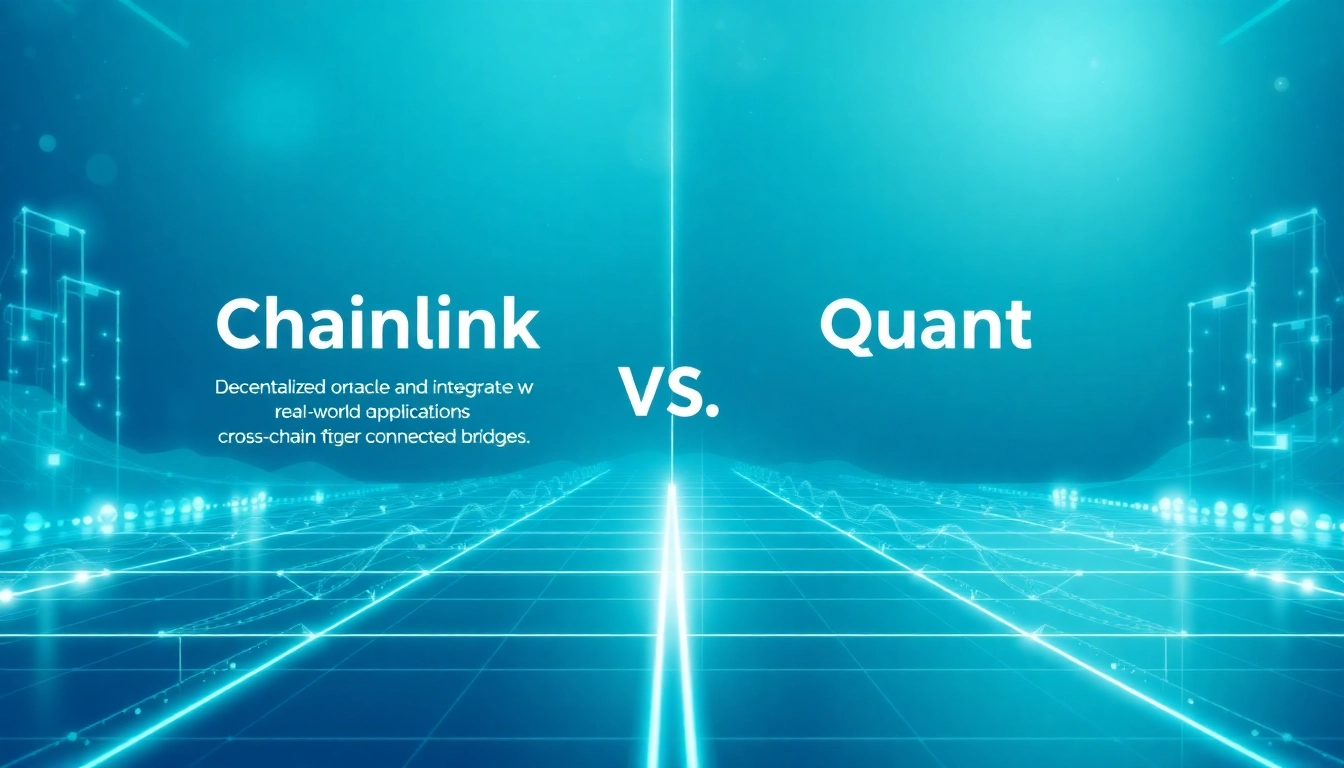Understanding the Fundamentals of Chainlink vs Quant
1. Overview of Their Technologies
The blockchain landscape is evolving rapidly, with various projects creating innovative solutions to persistent challenges. Two prominent entities in this space are Chainlink and Quant, each offering unique platforms with distinct technological underpinnings. Chainlink serves as a decentralized oracle network that facilitates the secure transfer of data between on-chain smart contracts and off-chain resources. Central to its operation are oracles, which function as intermediaries, fetching real-world data—such as price feeds, weather conditions, and event outcomes—and transmitting this information to blockchain networks. This capability allows developers to create decentralized applications (dApps) that rely on real-time, accurate data for optimal functionality.
Conversely, Quant operates as an interoperability protocol designed to bridge multiple blockchains, enabling seamless communication and data exchange across disparate blockchain networks. Its flagship product, Overledger, allows developers to build multi-chain applications without being tethered to a single blockchain. This technology is pivotal for businesses seeking to leverage the advantages of various blockchain ecosystems without the limitations often posed by singular platforms. Understanding these foundational technologies is essential when examining the competitive landscape and evaluating the use cases and potential of each project. For a deeper dive into the comparative analysis, you can check this chainlink vs quant discussion.
2. Core Functions and Use Cases
Chainlink’s core function revolves around decentralizing data sourcing for smart contracts. The utility of Chainlink extends across various sectors, including finance, insurance, and supply chain logistics. In finance, Chainlink’s technology enables decentralized finance (DeFi) applications to access real-time price data, which is critical for executing trades and managing collateral in a trustless environment. In insurance, it can help automate claims processing through reliable data verification. For supply chain logistics, Chainlink oracles provide transparency and real-time tracking, improving efficiency and accountability.
On the other side, Quant focuses on building a framework for interoperability. Through Overledger, users can design applications that span across multiple blockchains, which facilitates the sharing of assets and information. This is particularly valuable in industries like healthcare, where patient data and medical records can exist on different blockchain systems yet need to be integrated for a comprehensive management solution. Quant’s technology allows developers to create applications that harness the strengths of various blockchains, making it a versatile choice for businesses needing cross-platform compatibility.
3. User Benefits and Value Propositions
Both Chainlink and Quant offer compelling value propositions, catering to different needs in the blockchain ecosystem. Chainlink enhances the reliability and accessibility of on-chain data, significantly reducing the risks associated with data manipulation and inaccuracy. By ensuring that smart contracts have access to verified external data, the platform fosters trust in decentralized applications, promoting a more robust DeFi landscape.
Conversely, Quant’s primary user benefit lies in its ability to eliminate silos in blockchain technology. As organizations adopt more than one blockchain solution, the need for interoperability increases. Quant empowers businesses by allowing them to utilize the best features of various blockchains concurrently, streamlining operational processes and maximizing resource utilization. The ability to build applications that interact across multiple blockchains is a game changer for organizations that aim for flexibility and comprehensive blockchain strategy.
Comparative Analysis of Chainlink vs Quant
1. Performance Metrics and Data Handling
When evaluating Chainlink and Quant, performance metrics are crucial for understanding each project’s effectiveness. For Chainlink, metrics such as transaction speed, reliability of data delivery, and the number of integrated oracles are significant indicators of performance. Chainlink’s decentralized network comprises numerous oracles, ensuring data redundancy and reliability. The platform’s architecture allows it to process high volumes of requests efficiently, making it suitable for applications requiring fast and secure data transfers.
In contrast, Quant’s performance is measured through its ability to facilitate seamless interaction across differing blockchains. The efficiency of the Overledger network is traced through metrics such as latency in communication between blockchains, the throughput of transactions across the network, and the scalability of developed applications. Quant’s infrastructure aims to minimize these latencies, ensuring that applications built on Overledger can operate continuously without bottlenecks, thus maximizing user experience.
2. Scalability and Network Efficiency
Scalability is another vital factor distinguishing Chainlink from Quant. Chainlink is designed to accommodate an expanding number of oracles and data sources, allowing developers to scale their applications without compromising on data reliability or transaction performance. As demand grows, Chainlink can maintain its efficiency through a robust decentralized network that adds additional oracles, enhancing its capacity to serve dApps.
Quant’s scalability chiefly revolves around Overledger’s architecture, which supports multi-chain applications. As more blockchains enter the market, Quant can accommodate their integration without requiring substantial recalibrations of its network. This inherent flexibility positions Quant as an adaptable solution for future growth, aptly positioned to support enterprises looking towards multi-chain solutions as a foundation for their technological evolution.
3. Security Features and Protocols
Security is paramount in blockchain development, and both Chainlink and Quant emphasize providing robust security features. Chainlink employs a decentralized approach to oracle selection, reducing the risk of a single point of failure and ensuring that data is sourced from multiple reliable entities. Furthermore, its infrastructure is designed to withstand various types of attacks, such as Sybil attacks and data manipulation. Secure data feeds are integral to maintaining trust throughout decentralized finance applications where substantial sums of capital are at stake.
Quant, too, integrates robust security measures within Overledger. By enabling cross-chain communication, it implements cryptographic protocols that secure communications between different blockchain networks. This ensures that transactions remain confidential and tamper-proof. The architecture facilitates verified data transfers, thus preserving the integrity of assets and information exchanged across infrastructures.
Market Insights: Chainlink vs Quant
1. Current Market Trends and Pricing
The cryptocurrency market is highly volatile, and the dynamics of projects like Chainlink and Quant are influenced by broader market trends. Chainlink, having established itself as a leader in decentralised oracles, has seen varying pricing behavior correlated with the growth of decentralized applications and the adoption of DeFi protocols. Investors and users closely watch these trends to project future potential, with Chainlink’s price often reflecting the overall DeFi market’s performance.
Quant’s pricing, on the other hand, often mirrors its adoption rates within enterprises seeking interoperability solutions. Key factors influencing Quant’s market behavior include its integration success across multiple enterprises and the demand for multi-chain applications. As businesses increasingly recognize the importance of interoperability, Quant’s market presence strengthens, potentially leading to enhanced pricing stability and growth.
2. Adoption Rates and Community Support
Community support and adoption rates are essential metrics in determining the vitality of blockchain projects. Chainlink has garnered widespread usage among DeFi projects, establishing a strong community of developers and users. Its extensive partnerships with various blockchain networks and projects contribute to robust community engagement, indicating a definitive endorsement of its technology.
Quant also benefits from a growing ecosystem, especially as enterprises seek solutions for blockchain interoperability. The business-focused approach of Quant attracts organizations looking to integrate blockchain technology into their operations effectively. Community support, along with partnerships across sectors, demonstrates quant’s commitment to expanding its ecosystem and driving broader acceptance.
3. Future Projections and Growth Potential
Looking ahead, both Chainlink and Quant exhibit substantial growth potential in their respective domains. Chainlink is poised for expansion as the need for reliable data sources continues to rise in an ever-evolving DeFi landscape. With the increasing complexity of decentralized applications, the demand for secure and accurate data will likely drive Chainlink’s usage further. Projects leveraging Chainlink’s oracles can expect continued growth as the DeFi ecosystem winches closer into mainstream availability.
For Quant, its success hinges on the acceleration of blockchain adoption across various industries. As businesses begin to recognize the imperative to manage assets across multiple chains effectively, Quant’s Overledger stands to gain significant traction. By facilitating cross-chain applications, Quant can enable enterprises to operate more fluidly within the blockchain ecosystem, creating increased opportunities for growth and collaboration.
Challenges and Considerations in Chainlink vs Quant
1. Integration Challenges across Platforms
Integration is a common challenge in the blockchain ecosystem, particularly for projects like Chainlink and Quant. Chainlink faces potential hurdles when working with disparate blockchain protocols, requiring continuous adaptation to various blockchain standards. Additionally, as new blockchains emerge, ensuring compatibility with Chainlink becomes vital for maintaining its market position.
Quant also grapples with integration challenges, particularly as it evolves to include emerging blockchain technologies. The need for consistent updates and enhancements to Overledger ensures that it can connect with the diverse array of blockchains available. Adapting to the fast-paced technological developments in the crypto space is necessary for both organizations to secure long-term viability.
2. Regulatory and Compliance Issues
Regulatory scrutiny in the crypto space presents challenges for all blockchain projects, including Chainlink and Quant. Compliance with diverse international regulations can be complex and resource-intensive. Chainlink, being widely used in DeFi, must address concerns surrounding the legal status of smart contracts and the nature of decentralized finance. Uncertainty in regulatory frameworks can impact user adoption and project sustainability.
Quant, while focused on enterprise solutions, is influenced by regulatory developments in the business sector. The complexity of compliance when dealing with multiple jurisdictions can hinder the speed at which companies adopt Quant’s solutions. Adapting to the regulatory landscape is critical for both Chainlink and Quant to remain competitive and viable options within their respective fields.
3. Competition in the Blockchain Ecosystem
The blockchain ecosystem is rife with competition, making differentiation essential for both Chainlink and Quant. For Chainlink, competing decentralized oracle networks pose significant threats, necessitating ongoing innovation and feature enhancement to retain market share. As DeFi grows, new players may emerge, challenging Chainlink’s dominance in the oracle space.
Quant faces competition not only from other interoperability solutions but also from emerging blockchains that claim to provide seamless communication capabilities. As the focus shifts to multi-chain solutions, staying ahead of competitors will require diligent market research, a robust development pipeline, and strategic partnerships. Ensuring its relevance amidst this competition is paramount for Quant as industries look for trusted solutions.
Making Informed Choices: Chainlink vs Quant
1. Assessing Your Needs and Requirements
When deciding between Chainlink and Quant, it’s crucial to evaluate your specific needs and requirements. If your focus is on enhancing the reliability of smart contracts through reliable data feeds and you are engaged in the DeFi space, Chainlink may be the better option for you. Assess the type of data required for your applications and how Chainlink can bolster your operational efficacy.
Conversely, if you are part of an organization seeking to interact across multiple blockchains and need a solution that enables interoperability, Quant offers the infrastructure necessary to integrate diverse blockchain systems. In this scenario, your focus should be on how Quant’s Overledger can facilitate your business operations by breaking down data silos.
2. Comparison of Investment Strategies
For investors weighing opportunities in Chainlink and Quant, comparing investment strategies becomes critical. Both projects have distinct growth trajectories—Chainlink’s ties to the DeFi sector may attract investors looking for quick returns driven by surges in decentralized applications, while Quant’s enterprise-focused approach could foster long-term stability and growth as more businesses adopt blockchain interoperability.
Before making investment decisions, it is prudent to conduct thorough research, assess market conditions, and understand your investment goals. Monitor developments and trends impacting both projects to position your portfolio for greater resilience against market volatility.
3. Recommendations for Users and Developers
For developers looking to add value to their projects, the choice between Chainlink and Quant should be informed by the use-case scenario. Those developing in the DeFi space should integrate Chainlink oracles to access real-time data effectively. Participation in Chainlink’s community and ecosystem can also provide insights and support for building applications.
For users seeking solutions that bridge multiple blockchain networks, adopting Quant may yield significant advantages. Understanding the potential for interoperability might motivate businesses to develop applications that leverage both existing and new blockchain ecosystems. Engaging with the Quant community can provide resources and guidance essential for successful implementation.
Ultimately, both Chainlink and Quant provide innovative solutions that cater to varying needs within the blockchain core. Investors, developers, and users alike must carefully assess these platforms to leverage their unique strengths effectively while navigating the complex, evolving landscape of blockchain technology.



